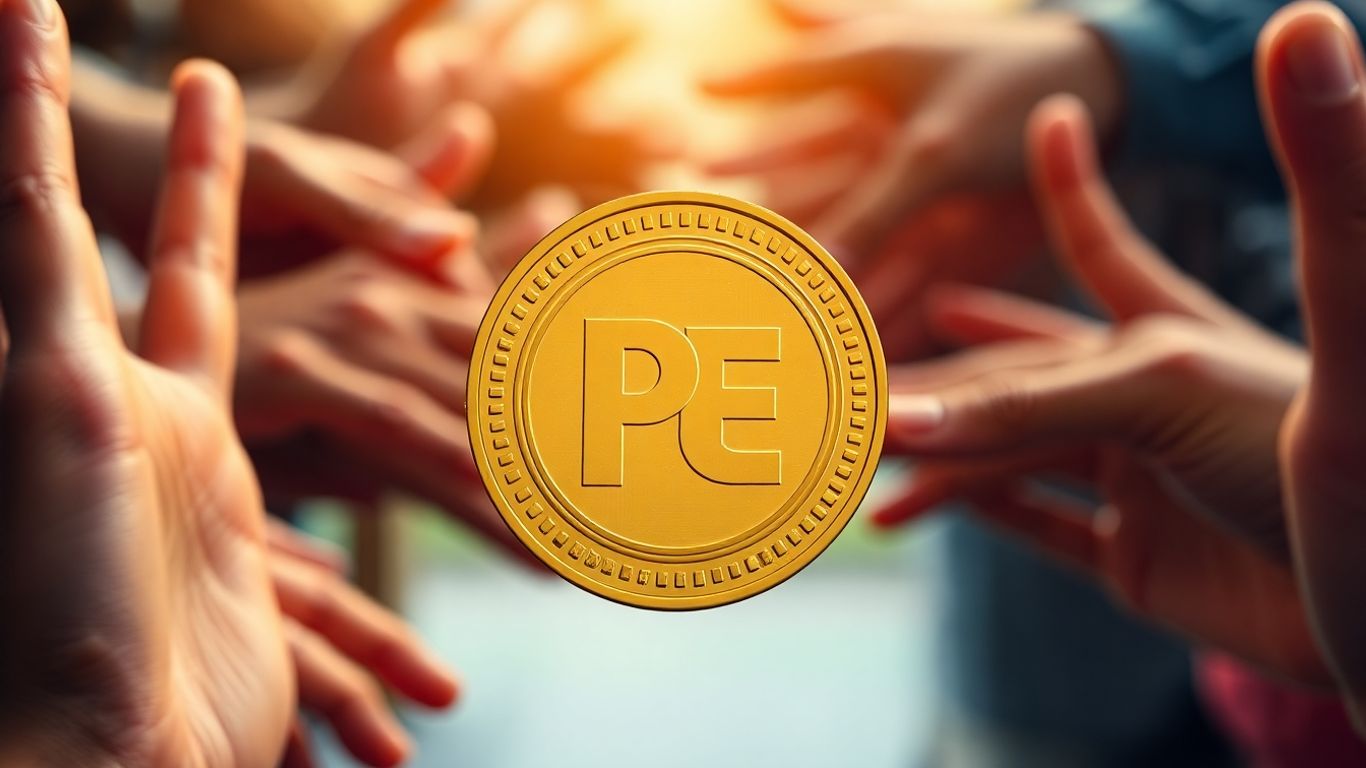Private equity used to be this really exclusive club, right? Only the big players, like massive investment firms and super-wealthy individuals, could really get in. But things are changing, and fast. Technology, especially blockchain, is starting to make private equity more open, more efficient, and, importantly, more liquid. It’s like the doors to this exclusive party are finally creaking open for more people. This shift is largely thanks to fractionalized private equity, which is making it possible for more investors to get a piece of the action.
Key Takeaways
- Tokenization breaks down private equity investments into smaller digital pieces, allowing more people to invest by lowering the initial cost. This is the core of fractionalized private equity.
- Digital tokens on a blockchain make it easier and faster to buy and sell stakes in private companies, moving away from the old, slow methods.
- Blockchain technology provides a clear, unchangeable record of who owns what, making private equity investments more transparent and secure.
- Automating tasks like investor checks and paperwork with smart contracts cuts down on costs and speeds up the whole investment process.
- Big financial companies are starting to use tokenization, showing that they trust this new way of investing and expect it to grow.
Democratizing Access Through Fractionalized Private Equity
Private equity used to be this really exclusive club, right? Only the big players, like massive investment firms and super-wealthy individuals, could really get in. But things are changing, and fast. Technology, especially blockchain, is starting to make private equity more open, more efficient, and, importantly, more liquid. It’s like the doors to this exclusive party are finally creaking open for more people.
Lowering Investment Minimums for Broader Inclusion
Traditionally, getting a piece of the private equity pie meant having a lot of cash upfront. We're talking hundreds of thousands, sometimes millions, of dollars. This naturally shut out most people from even considering it. But tokenization flips that script. By breaking down ownership into tiny digital pieces, or tokens, you can now invest with much smaller amounts. Think of it like buying a single share of a company instead of having to buy the whole business. This fractional ownership means more investors, not just the ultra-wealthy, can access these kinds of opportunities. It’s a big step towards making investment markets fairer for everyone.
Transforming Exclusive Markets into Accessible Opportunities
These private markets, filled with promising startups and established private companies, were always a bit of a mystery to the average person. High entry barriers kept them out. Now, with tokenization, these markets are becoming more accessible. Platforms are emerging that allow investors to buy tokens representing stakes in these companies. This means you don't need to be a big institution to get involved in potentially high-growth private companies. It’s about opening up these exclusive opportunities to a wider audience, making the investment landscape more diverse.
Enabling Wider Participation Beyond High-Net-Worth Individuals
So, what does this all mean in plain English? It means that the average person, someone who might not have millions lying around, can now potentially invest in the same kinds of assets that were once only available to the super-rich. This democratization is a game-changer. It allows for a broader base of investors to participate, bringing more capital into private markets and, in turn, potentially fueling more innovation and growth. It’s about leveling the playing field and giving more people a chance to build wealth through investments that were previously out of reach. This shift is making it possible for more people to get involved in private equity tokenization.
The core idea is to take something that was historically difficult to access and trade, and make it simpler and more available. It’s about using technology to break down old barriers and create a more inclusive financial future.
The Mechanics of Tokenizing Private Equity Investments

So, how does this whole tokenization thing actually work, especially when we're talking about private equity? It's not just magic; there's a pretty clear process involved, and it brings together legal stuff, tech, and how things are run. Each step is important to turn what used to be a paper certificate or a complex agreement into a digital asset that can actually be traded.
Structuring Assets and Legal Frameworks
First off, you've got to pick what you're going to tokenize. For private equity, this could be shares in a company, parts of a fund, or even loan agreements. Once you've chosen the asset, lawyers get involved. They figure out the best legal setup based on what the asset is, who's investing, and where everyone is located. This is super important for staying on the right side of the law. If the tokens are considered securities, then you have to follow rules like knowing your customer (KYC) and anti-money laundering (AML) procedures. Sometimes, a special legal entity, like a Special Purpose Vehicle (SPV), is created to make ownership clearer and work better with the blockchain side of things.
Creating Digital Tokens with Smart Contracts
After the legal groundwork is laid, it's time for the tech part: making the actual digital tokens. This is where smart contracts come into play. These are like digital agreements written in code that live on the blockchain. They control how tokens are issued, how they can be transferred, and even how things like dividends or voting rights work. Developers pick a token standard that fits the asset – like ERC-20 for regular tokens or ERC-1400 for tokens that need extra compliance features. These tokens are then 'minted,' or created, on a blockchain, often Ethereum or a more private network, depending on what the project needs.
Listing on Specialized Trading Platforms
Once the tokens are created and the underlying asset is legally set up, the next step is getting them out there. This usually means listing them on specialized trading platforms or exchanges where interested investors can buy and trade them. These platforms are designed to handle digital assets and often have built-in compliance features.
The core idea is to simplify what was once a complex, paper-heavy process into a digital, blockchain-based system that's easier to manage and trade.
Here's a quick look at the general process:
- Asset Identification & Legal Structuring: Pinpointing the exact asset and setting up the necessary legal wrappers, like SPVs, to comply with regulations.
- Token Creation: Developing smart contracts that define the token's properties and functionalities on a chosen blockchain.
- Platform Integration: Listing the newly created tokens on a regulated or specialized digital asset exchange for trading.
This whole process is what allows tokenized private equity to move from being a concept to a tangible investment opportunity.
Enhancing Liquidity and Transaction Speed
One of the biggest headaches with private equity has always been getting your money out. Traditionally, if you invested in a private fund, you were pretty much locked in for years, maybe even a decade. Selling your stake before the fund wrapped up was a complicated dance, often involving finding a buyer yourself and navigating a maze of paperwork. It wasn't easy, and it definitely wasn't fast. This is where tokenization really shines. By turning ownership stakes into digital tokens, we create a pathway to a much more active secondary market. Think of it like this: instead of a private equity share being a rare collectible that only a few people know how to trade, it becomes something that can be listed and bought or sold on specialized digital platforms. This makes it way easier for investors to exit their positions if they need to, or just to rebalance their portfolios without waiting for the fund's natural end. The ability to trade tokens on secondary markets transforms traditionally illiquid private equity stakes into more fluid assets.
From Illiquid Stakes to Fluid Digital Assets
Private equity investments are known for being pretty stuck in place for a long time. You put your money in, and it's usually there for seven to ten years, sometimes longer. This lack of movement, or illiquidity, means you can't easily sell your stake if you need cash or want to invest it somewhere else. Tokenization changes this by breaking down ownership into smaller digital tokens. These tokens can then be traded on specialized exchanges built for these kinds of digital assets. It's like turning a locked-in investment into something you can actually trade, which is a huge deal for managing your money. This opens up new possibilities for investors who need more flexibility.
Facilitating Earlier Realization of Investment Gains
Imagine you invested in a promising tech startup through a private equity fund. A few years later, that startup is doing incredibly well, but you've got another investment opportunity that needs capital right now. With tokenization, you could potentially sell your tokens representing that private equity stake on a secondary market. This means you're not stuck waiting for the fund to liquidate; you can access your capital much sooner. It also allows fund managers to rebalance their portfolios more efficiently, perhaps selling off a portion of an older investment to make room for a new one. This shift provides investors with greater flexibility and can significantly speed up the realization of investment gains, moving away from the long, often opaque, lock-up periods of the past. You can find out more about how tokenization is changing the financial landscape at tokenization revolutionizing investments.
Enabling 24/7 Trading Opportunities
Traditional financial markets have set hours. You can only buy or sell stocks during specific times on weekdays. But with tokenized private equity, trading can happen anytime, day or night, weekends included. This constant availability means more chances to trade and can lead to better prices because you're not limited by market opening hours. It also means that investors across different time zones can participate more easily. This continuous trading environment boosts overall market activity and makes it simpler for everyone to get involved when it suits them.
Boosting Transparency and Security in Private Markets
One of the biggest headaches with private equity has always been getting your money out. Traditionally, if you invested in a private fund, you were pretty much locked in for years, maybe even a decade. Selling your stake before the fund wrapped up was a complicated dance, often involving finding a buyer yourself and navigating a maze of paperwork. It wasn't easy, and it definitely wasn't fast. This is where tokenization really shines. By turning ownership stakes into digital tokens, we create a pathway to a much more active secondary market.
Immutable Record-Keeping on the Blockchain
When you own a token representing private equity, everything is recorded on a blockchain. This creates a clear, unchangeable history of who owns what and when transactions happened. It’s much harder for things to get lost or messed with compared to old paper records. This means that every single transaction, every ownership change, is logged permanently and can be checked by anyone with access to the ledger. It’s like having a super-secure digital notary for your investments.
Automated Processes with Smart Contracts
Smart contracts are basically self-executing contracts with the terms of the agreement directly written into code. They live on the blockchain and can automatically handle things like dividend payouts or making sure only the right people can trade the tokens. For instance, a smart contract could automatically distribute profits to token holders on a set schedule, without any manual intervention. This makes the whole process more secure and trustworthy, cutting down on potential errors or fraud.
Reducing Risks of Lost or Tampered Records
Think about all the paper certificates and spreadsheets that used to track ownership. Those can get lost, damaged, or even altered. Blockchain technology, by its very nature, makes records immutable. Once a transaction is verified and added to the chain, it can't be changed or deleted. This drastically reduces the risk of records being lost, tampered with, or disputed. It brings a level of certainty to ownership that was previously hard to achieve in private markets.
The shift towards tokenized private equity isn't just about adopting new technology; it's about fundamentally rethinking how assets are managed, traded, and accessed. It's about creating a more open and efficient financial system for everyone involved.
Here's a quick look at how tokenization helps:
- Fractional Ownership: Assets are broken down into smaller tokens, allowing more investors to participate.
- 24/7 Trading: Unlike traditional markets, tokenized assets can often be traded around the clock.
- Wider Market Access: More platforms can list tokenized assets, increasing the pool of potential buyers and sellers.
Streamlining Operations and Reducing Costs
Think about the old way of doing things in private equity. It was a lot of paperwork, a lot of phone calls, and a whole bunch of people in the middle making sure everything was done right. Tokenization is changing all that, making the whole process much simpler and cheaper.
Automating Investor Onboarding and Compliance
Getting new investors on board used to be a real chore. You had to collect tons of documents, verify identities, and make sure everyone followed all the rules. With tokenization, a lot of this can be automated. Smart contracts can handle identity checks and compliance requirements right from the start. This means less manual work for the fund managers and a quicker, smoother experience for investors. It's like having a digital assistant that handles all the tedious stuff.
Cutting Out Traditional Paperwork and Intermediaries
Remember all those physical certificates and lengthy legal documents? Tokenization replaces a lot of that with digital records on the blockchain. This not only saves on printing and mailing costs but also cuts out many of the intermediaries, like brokers or custodians, who used to take a cut. When you remove these middlemen, you naturally reduce fees and speed up transactions. It’s a win-win: lower costs for the fund and more of the investment going directly to the asset.
Improving Portfolio Management and Ownership Transfers
Managing a private equity portfolio can get complicated, especially when it comes to tracking ownership and handling transfers. Tokenization makes this much easier. Because ownership is recorded digitally on an immutable ledger, it's always clear who owns what. Transferring ownership becomes as simple as transferring a digital token, which can be done quickly and efficiently. This makes it easier for fund managers to keep track of their holdings and for investors to manage their stakes.
The shift towards tokenized private equity isn't just about adopting new technology; it's about fundamentally rethinking how assets are managed, traded, and accessed. It's about creating a more open and efficient financial system for everyone involved.
Here's a quick look at how operations get simpler:
- Reduced Administrative Burden: Less manual data entry and document handling.
- Faster Transaction Settlements: Digital transfers are quicker than traditional methods.
- Lower Transaction Fees: Cutting out intermediaries means fewer fees.
- Enhanced Record Keeping: Blockchain provides a clear, unchangeable history of all transactions.
This move towards efficiency means that more capital can be focused on the actual investments, rather than getting tied up in administrative tasks. It's a significant step in making private equity more accessible and cost-effective.
Institutional Adoption and Market Confidence in Tokenization

It's pretty wild to see how many big players in the finance world are starting to get on board with tokenization. When you have names like BlackRock or Franklin Templeton actually launching tokenized funds, it’s not just a small experiment anymore. This kind of involvement acts like a big stamp of approval, making a lot of other investors feel way more comfortable. It’s like when a famous chef tries a new dish; suddenly, everyone else is curious and willing to give it a go. These institutions bring their own resources and networks, which helps build out the whole market and make it more stable.
Major Financial Players Embracing Tokenized Assets
When these established firms get involved, it really validates the whole idea of tokenized assets. They're not just dipping their toes in; they're actively creating and managing these products. This signals to regulators and other investors that tokenization is moving beyond just a tech concept and becoming a real part of the financial system. It encourages the development of better infrastructure, like secure digital custody solutions, which are super important for this market to grow.
Growing Confidence in Blockchain-Based Investments
Seeing these big financial names succeed with tokenized funds provides real-world proof that the technology works and can be managed within existing financial rules, even if it's a new way of doing things. These success stories chip away at any lingering skepticism. It shows that tokenized assets can be legitimate and reliable, not just some fringe idea. This growing confidence is what helps push the market towards wider acceptance, making it easier for tokenization to become a standard option for investors.
The Role of Regulatory Sandboxes in Innovation
Navigating the rules around digital assets can be a real headache, especially since regulations differ so much from place to place. That's where regulatory sandboxes come in. These are basically controlled environments set up by regulators where companies can test out new, innovative financial products, like tokenized assets, without immediately facing all the usual strict rules. It's a smart way for regulators to learn about this new tech and for companies to figure out how to make their products compliant. It helps bridge the gap between cutting-edge ideas and the need for investor protection. Think of it like a safe space to experiment and figure out the best way forward, which ultimately helps build trust and clarity for everyone involved.
- Validation: Major institutions lend credibility to tokenization.
- Liquidity: Their involvement can attract more capital and market makers.
- Infrastructure: They push for the development of necessary tech and custody solutions.
- Standard Setting: Collaboration helps create best practices and technical standards.
The Future Landscape of Tokenized Private Equity
So, what's next for tokenized private equity? It's not just about making things a bit easier today; it's about building a whole new way of doing things for tomorrow. We're looking at a future where private markets are way more connected and efficient. The integration of advanced technologies is set to redefine how we interact with these exclusive investment opportunities.
Increased Capital Efficiency Through Streamlined Processes
Think about all the time and money that goes into the old ways of managing private equity. Lots of paperwork, lots of people involved, and a lot of waiting around. Tokenization is already starting to cut through that. By automating things like investor checks and paperwork with smart contracts, we're seeing less capital tied up in administrative tasks. This means more money can actually go into the investments themselves, making everything work better for everyone. It's like clearing out the clutter so the real work can happen faster and smoother.
Integration of Artificial Intelligence in Asset Management
Artificial intelligence, or AI, is going to play a bigger role too. Imagine AI helping to sort through potential investments, analyzing market trends in real-time, or even personalizing investor communications. It could also help manage portfolios more effectively, spotting risks or opportunities that humans might miss. This isn't about replacing people, but about giving them better tools to make smarter decisions. It's about making the whole management process more intelligent and responsive.
Emergence of New Financial Products and Trading Mechanisms
As tokenization becomes more common, we'll probably see some really interesting new investment products pop up. We might see more specialized funds that are easier to trade, or even ways to combine different tokenized assets. The way we trade these tokens will also likely evolve. We could see more sophisticated trading platforms that offer more features, perhaps even integrating with other digital asset markets. It's all about creating more options and making it easier for investors to build diverse portfolios in the private markets.
The shift towards tokenized private equity isn't just about adopting new technology; it's about fundamentally rethinking how assets are managed, traded, and accessed. It's about creating a more open and efficient financial system for everyone involved.
Here's a quick look at what we can expect:
- Faster Transactions: Trades settling in minutes, not weeks.
- Reduced Costs: Fewer middlemen means lower fees.
- Global Reach: Investing from anywhere, breaking down borders.
- Fractional Ownership: Making private equity accessible to more people with smaller amounts of money.
The Road Ahead for Tokenized Private Equity
So, what does all this mean for private equity? Basically, tokenization is changing the game. It's taking something that was always a bit hard to get into – private equity – and making it more open and easier to trade. Think of it like turning a big, old, hard-to-move statue into smaller, manageable pieces that more people can buy and sell. This means more investors, from big institutions to regular folks, can now get a piece of the action. While it's still early days, and there are definitely kinks to work out, like making sure everything is legal and secure, the trend is clear. Tokenization is paving the way for a future where private markets are more accessible, more liquid, and just plain more efficient for everyone involved. It’s a big shift, and it’s happening now.
Frequently Asked Questions
What is tokenization in private equity?
Imagine taking a piece of ownership in a private company, like a digital certificate, and putting it on a secure online ledger called a blockchain. That's basically tokenization for private equity. It turns a hard-to-trade investment into a digital token that can be bought and sold more easily, making it accessible to more people.
How does tokenization make private equity easier to invest in?
Normally, you need a lot of money to invest in private equity, and your money is locked up for a long time. Tokenization breaks down ownership into smaller pieces, like buying a slice of pizza instead of the whole pie. This lowers the amount of money you need to start, and because the tokens can be traded more easily, your money isn't stuck for as long.
Is tokenized private equity safer than traditional private equity?
Tokenization uses blockchain, which is like a super secure digital record book that's very hard to change or cheat. This makes ownership and transactions very clear and trustworthy. Plus, special computer programs called smart contracts can help manage things automatically, reducing the chance of mistakes or fraud.
Can anyone invest in tokenized private equity, or is it still just for the rich?
The main goal of tokenization is to open up private equity to more people. By lowering the minimum investment amount and making it easier to trade, it allows individuals who aren't super wealthy to participate. So, yes, it's becoming much more accessible to a wider range of investors.
What are the main benefits of tokenizing private equity?
The biggest benefits are making it easier for more people to invest (democratization), allowing investments to be bought and sold more quickly (liquidity), making everything more open and clear (transparency), and using technology to make the whole process faster and cheaper (efficiency).
Is tokenized private equity the future of investing?
Many experts believe it is. Big financial companies are already exploring and using tokenization. While there are still some rules and technical things to figure out, the trend is towards making private investments more open, easier to trade, and more efficient for everyone involved.




